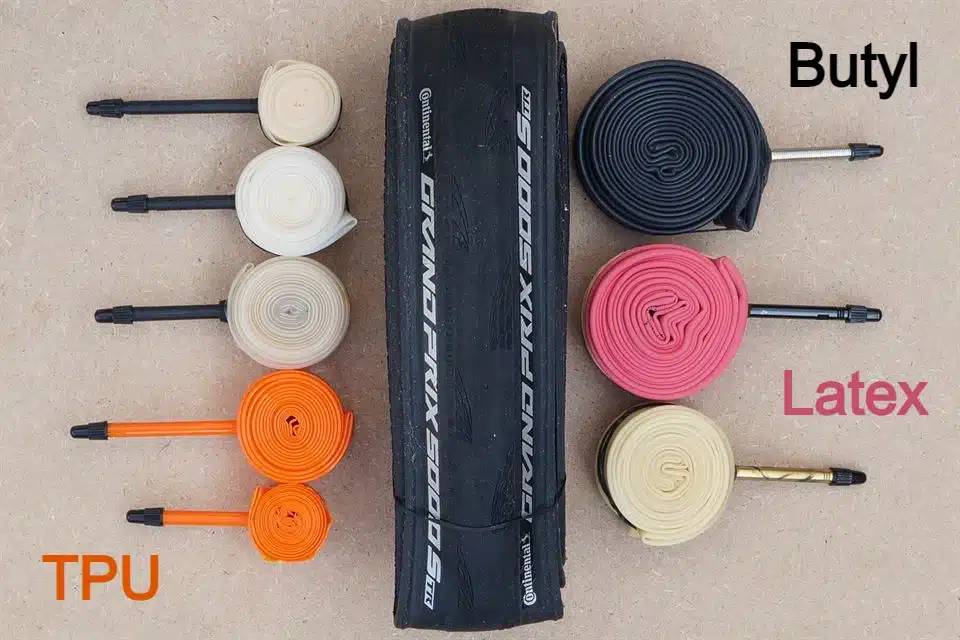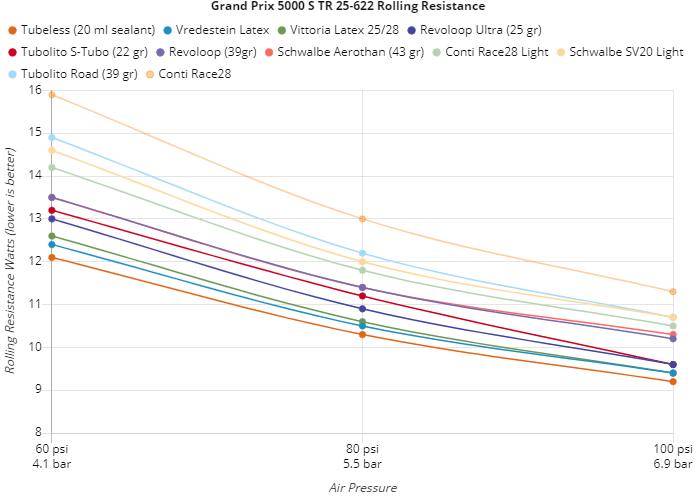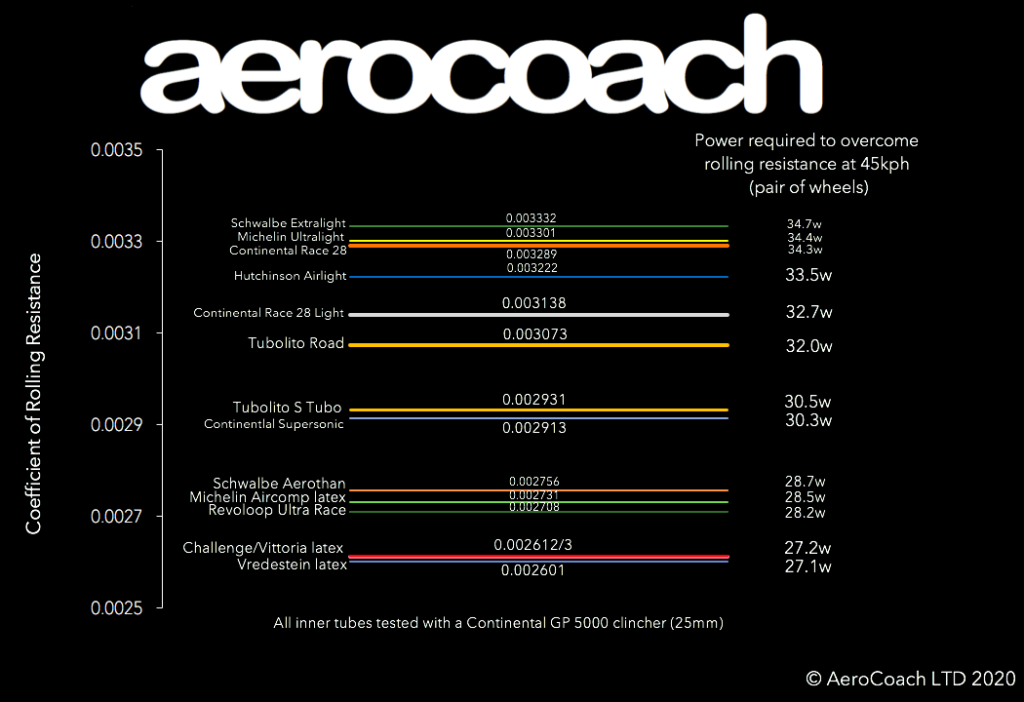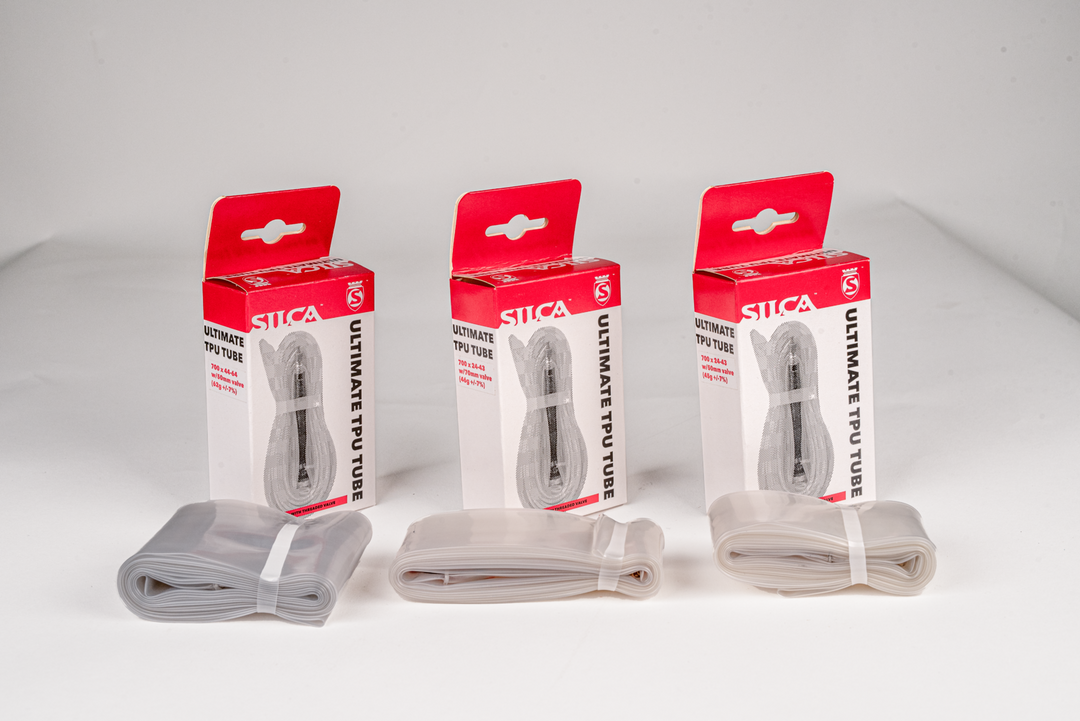Mounting a tire without an inner tube, commonly known as tubeless, is generally the fastest option in nearly any condition. By choosing tubeless, you can save around 7 watts compared to traditional butyl tubes.
If tubeless tires are not an option, latex tubes are a good alternative and are nearly as fast. Furthermore, the latest TPU tubes released in 2025 have improved upon the propensity for failures of the past and have become an easy-to-mount, reliable option that can be made with very little material. They are almost as fast as latex tubes and pack down very small for repair kits. Still, traditional black butyl tubes still remain a reliable and cost-effective choice.
What are my Options for mounting Road tires?
There are three main types of mounting pneumatic tires on bicycle wheel rims: tubular, tubeless, and clincher, with the clincher option using an inner tube.
- Tubular: The tire is shaped like a tube and glued onto the rim. It’s cumbersome, requires a lot of work, and is not even faster than modern clincher setups. It won’t be covered here since it’s rarely used.
- Tubeless: as the name suggests, it involves mounting the tire without an inner tube. A liquid, called a sealant, is mainly combined with it, serving to make the tire airtight and offering some self-repair in case of a puncture.
- Clincher Butyl tubes: the classic, black tubes made of synthetic butyl rubber
- Clincher TPU tubes: newer tubes, often colored or translucent, made of thermoplastic polyurethane
- Clincher Latex tubes: you guessed it, made of latex and often in pinkish or pastel-like colors
If you are looking for extensive coverage of bicycle tire topics, this video from GCN is recommended.

Which is faster: tubeless, TPU or butyl?
The well-trusted site Bicycle Rolling Resistance aimed to answer this question using our favorite Continental GP 5000 S TR tire, tested with different inner tubes and a tubeless setup. Below is a graph displaying the rolling resistance testing data at pressures of 100 PSI, 80 PSI, and 60 PSI. A lower line on the graph indicates less resistance, meaning that setup is faster.
Pressures between 60 and 80 PSI are likely the most realistic for current setups using 25-30mm road bike tires. As discussed elsewhere, the fastest pressure might be lower than you expect.

Tubeless is the fastest option to mount a road bike tire
Tubeless tires offer the fastest option with the least rolling resistance. In this test, 20 mL of sealant was used. Other tests conducted by Aerocoach have demonstrated that it’s possible to use up to 30 mL of sealant without experiencing any loss in speed. However, using more than that tends to slow the setup down slightly.
Tubeless setups are not only about speed. The sealant inside the tire can also serve as insurance against punctures. Especially the newer generations of sealant work quite well, even at higher pressures of road setups.
On the other hand, sealant can serve as insurance against punctures and effectively seal small holes. In recent years, sealant technology has evolved significantly and now works reliably even at the higher pressures of road tires. However, there is a downside: the sealant dries out over time and needs to be checked and replaced regularly. If it dries up, it can be quite tricky to clean out, and leaving it in can slow down the tire.
Latex is almost as fast as tubeless, while TPU is the lightest option
Latex is the second fastest material choice for bicycle tubes. Vredenstein Latex, weighing only 50 grams, is slightly faster than Vittoria Latex, which weighs 80 grams. Interestingly, the Vittoria tube is faster than some much lighter TPU or butyl tubes, despite being heavier. This demonstrates the inherent advantages of latex as a material (see explanation below). However, a downside of latex is its relatively rapid loss of air pressure, so you will need to pump it up before every ride.
TPU does not seem to differ much in the energy return properties of the material compared to butyl. However, because TPU tubes can be constructed very light and thin (about half the weight of butyl), there is less energy loss, and they tend to be a little faster.
The latest generation of TPU tubes has improved many initial issues with this technology: they are less prone to blowouts, failures at the valve stem, and are faster since no dye is used in the transparent versions.
Butyl tubes are the heaviest and slowest at 105 g for the popular Continental Race28. However, the thinnest butyl tube, Continental Race28 Light, tests even a little faster than the much lighter Tubolito Road, which weighs only 39 g. This again suggests that TPU does not have an inherent advantage over butyl when it comes to the material used.
Aerocoach testing verifies the rolling resistance data
In another blog post, Aerocoach, a renowned company in this field, provided effectively the same data when they tested a series of inner tubes. The testing protocol was done on rollers, and you can see that the watt numbers are roughly twice the value for Bicycle Rolling Resistance due to a different setup and losses in the whole drivetrain. This is arguably more realistic, but we mostly care about the relative order, not those absolute numbers.
TPU inner tubes, such as Revoloop, Tubolito, and Aerothan, provide a weight advantage compared to traditional butyl tubes. Choose the transparent TPU tubes because they are faster, as colorants impact the plastic properties.
In the Aerocoach test, Latex tubes are the fastest, followed by TPU tubes, while butyl tubes are the slowest. As expected, lighter tubes tend to be faster. However, in this test, the Tubolito Road TPU tubes were found to be slower than the Schwalbe Aerothan TPU tubes, even though they are of similar weight. The difference in speed is attributed to the colored dye used in the Tubolito tubes. The colorants are large molecules that alter the chemical properties of the TPU, which, in this case, makes it slower.

Why is tubeless fastest?
As discussed in another post, a faster tire has minimum energy loss when undergoing compression and decompression cycles while rolling along the pavement. When including a tube, the friction between the tube and the tire creates an additional energy loss compared to tubeless. In general, the less material, the less energy is lost. That’s why thinner tubes generally will be faster but offer less puncture protection!
Going tubeless can save you about 7 watts compared to traditional butyl tubes. If that’s not an option, consider using latex tubes, which are equally fast.
Another aspect is how much energy the tire and tube combination returns after being compressed. The more it returns, the less energy is lost and the faster the system is. It is again all down to the hysteresis of the material, as the video below illustrates.
When should I not use tubeless?
There are a couple of scenarios where tubeless may not be the best choice. Obviously, when speed is not a major concern, you find working with sealant and pumps too much of a hassle.
Latex is the fastest option for Track Cycling
Using latex is your best option when you want a clean and fast solution without the hassle of mounting tubeless. The only disadvantage is that air is lost quickly at about 1 PSI per hour. This means you must pump before every ride, which can be especially difficult on multi-day events. In terms of product, judging from customer feedback at the big distributors, the Vittoria Competition inner tubes seem to be better built and with the consistent quality compared to the Vredestein Race Latex.
Latex inner tubes are almost as fast as tubeless. Why? Latex returns 75% of the energy compared to 20% of standard butyl tubes. Less energy lost and hence faster!
In track cycling, imagine getting a flat tire and spraying sealant all over the track! You might never want to show your face at that velodrome again. It’s likely also prohibited. In this scenario, using a latex tube is ideal, as the sessions are short and you can easily re-inflate the tires. While tubular tires remain popular in this discipline due to their ability to withstand high pressures and stay securely on the rim, more and more cyclists are now switching to latex tubes.
The latest TPU tubes are becoming a real alternative to consider
Until recently, I primarily viewed TPU tubes as spare options. Even when using a tubeless setup, it is advisable to carry a spare tube as a backup, along with tubeless plugs. TPU tubes are the lightest and take up the least space, making them ideal for this purpose.
With the arrival of the new Silca TPU tubes, I am starting to change my perspective. Previously, based on comments I’ve seen online and experiences shared by the local cycling community, I experienced the thin TPU tubes being prone to blowouts and punctures regardless of the brand. The common points of failure were typically around the valve and where the tube is sealed.
In their launch video, Silca provides an excellent explanation of why these failures occur and how they addressed the issues. This has led me to seriously reconsider the use of TPU, especially for bicycles, where maintaining tubeless setups can be quite cumbersome and speed isn’t the top priority.
Finally, the good old butyl spare tubes like the Continental Race28 still have not lost their appeal. It’s cheap and simple to set up, whether as a spare or if you just want to get going. It may not be the fastest, but it gets you rolling.
 Made me Slower
Made me Slower
 Same, Same
Same, Same
 Made me Faster
Made me Faster






